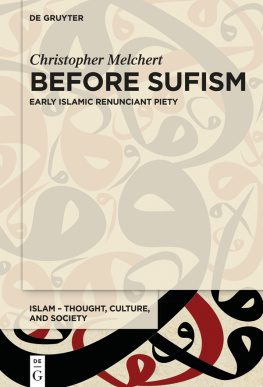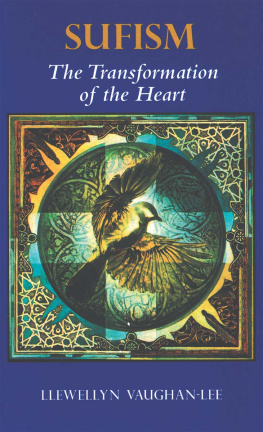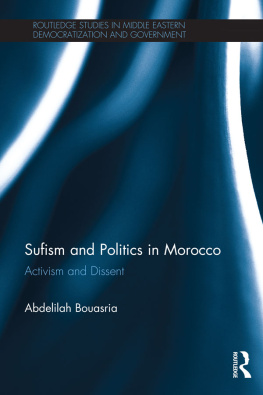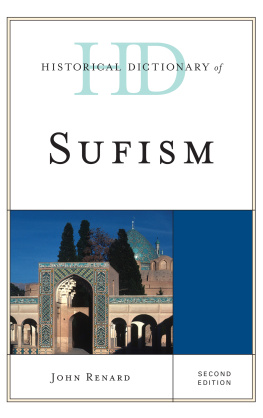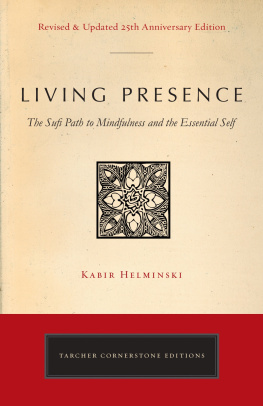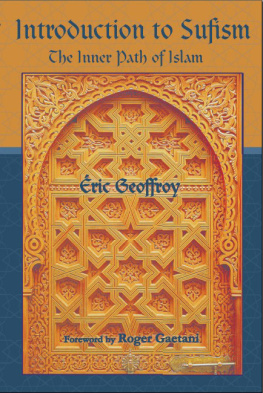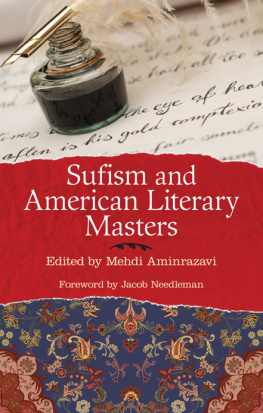
SUFISM
Sufism
A NEW HISTORY OF ISLAMIC MYSTICISM

Alexander Knysh
PRINCETON UNIVERSITY PRESS
PRINCETON & OXFORD
Copyright 2017 by Princeton University Press
Requests for permission to reproduce material from this work
should be sent to Permissions, Princeton University Press
Published by Princeton University Press,
41 William Street, Princeton, New Jersey 08540
In the United Kingdom: Princeton University Press,
6 Oxford Street, Woodstock, Oxfordshire OX20 1TR
press.princeton.edu
All Rights Reserved
Library of Congress Cataloging-in-Publication Data
Names: Knysh, Alexander D., author.
Title: Sufism : a new history of Islamic mysticism / Alexander Knysh.
Description: Princeton ; Oxford : Princeton University Press, 2017. | Includes bibliographical references and index.
Identifiers: LCCN 2017016916 | ISBN 9780691139098 (hardcover : alk. paper)
Subjects: LCSH: SufismHistory. | MysticismIslamHistory.
Classification: LCC BP189 .K695 2017 | DDC 297.4--dc23 LC record available at https://lccn.loc.gov/2017016916
British Library Cataloging-in-Publication Data is available
This book has been composed in Miller
Printed on acid-free paper.
Printed in the United States of America
10 9 8 7 6 5 4 3 2 1
To my ever-curious grandson
Alexander Knysh Jr.
CONTENTS
ILLUSTRATIONS AND DIAGRAMS
TRANSLITERATION AND DATES
THE AUTHOR has used a simplified transliteration of Arabic, Persian, and Turkish names and terms that makes no distinction between emphatic and nonemphatic consonants (usually conveyed in specialized academic books by Latin letters with dots underneath). Macrons (short stroke marks above Latin vowels) to differentiate between the long and short vowels of the Arabic alphabet have not been used either. The Arabic letter ayn is conveyed by a single quotation mark (). The Arabic hamza in the middle or at the end of a word is marked by a closing quotation mark (). The simplified transliteration was adopted by the author to facilitate the reception of the book by the reader with no prior knowledge of academic transcription conventions. Some exceptions apart, the author has adhered to the spelling of Muslim names and terms that is current in the Englishspeaking media. The dates are given according to the Common Era calendar (henceforth CE) preceded by the Muslim, Hijra(h), calendar equivalents.
ACKNOWLEDGMENTS
THIS BOOK owes its existence to the support of several academic institutions as well as the suggestions, insights, and help of the authors friends and colleagues. First, I am deeply indebted to the Helsinki Collegium for Advanced Studies whose administration kindly hosted me as a visiting fellow of the European Association of Institutes for Advanced Studies (EURIAS) in 201415. I am grateful to my colleagues at EURIAS for awarding me a generous research grant that allowed me to focus on my research for this book. Second, I would like to gratefully acknowledge the assistance and encouragement of my colleagues at the Saint Petersburg State University, especially the Rectors office and the leadership of the Oriental Faculty (Vostochnyi fakultet) whose commitment to advancing Islamic studies deserves the highest praise. Third, I thank the administrators of the University of Michigan for facilitating the completion of my book by granting me an academic leave in the fall of 2016. As far as individuals are concerned, I would like to extend my heartfelt thanks to Fred Appel, my editor at Princeton University Press, for his patient and benevolent guidance and encouragement. Had it not been for him, this book would have never seen the light of the day. I would also like to thank the anonymous reviewers of the manuscript of my book for their judicious and constructive analysis of its content and helpful suggestions for its improvement. My special thanks goes to Mrs. Evyn Kropf of the Hatcher Graduate Library of the University of Michigan for her help with identifying and copying the manuscript pages that were used as illustrations for my book. Last but not least, I am grateful to my wife Anna Knysh for her creative contributions to my thinking about Sufism, Islam, and religion in general. In particular, I cannot thank her enough for her assistance with the index, tables, and illustrations as well as her intellectual companionship throughout our married life. I dedicate this book to the youngest male member of our family, Alexander Knysh Jr. (better known as Sashulka). As the author, I bear full responsibility for any factual or printing errors that may have crept into my text.
For permission to quote material in my epigraphs, I gratefully acknowledge the following publishers: Reassembling the Social: An Introduction to Actor-Network Theory by Bruno Latour (2007), Oxford University Press; Holy Terrors: Thinking about Religion after September 11, Second Edition by Bruce Lincoln (2006), The University of Chicago Press; Globalized Islam: The Search for a New Ummah by Oliver Roy (2004), Columbia University Press and C. Hurst & Co., Ltd.
SUFISM
Introduction
How else can any past, which by definition comprises events, processes, structures, and so forth, considered to be no longer perceivable, be represented in either consciousness or discourse except in an imaginary way?
HAYDEN WHITE, THE CONTENT OF THE FORM
THIS BOOK IS ABOUT SUFISM, the ascetic-mystical stream in Islam that emerged at the very early stage of this religions development and that subsequently took a wide variety of devotional, doctrinal, artistic, and institutional forms. Sufisms internal diversity has produced an equally wide variety of its assessments by both insiders and outsiders. They range from soberly detached and critical to empathetically enthusiastic and apologetic. Our study of the phenomenon of Sufism itself and its conceptualizations by various actors with vastly different intellectual and devotional agendas will reveal a great deal not just about Sufism but also about human beings religious imagination more generally. What lies beyond this imagination does not concern us here. We leave it to believers, philosophers, and theologians to explore and appreciate.
Our task is to examine how Sufism has been imagined and, in the case of insiders, practiced based on this imagination, by various parties and actors since its inception up to the present. Our approach to the subject is inspired, in part, by Hayden Whites (b. 1928) aforementioned statement about history as a product of imagining and emplotment
As some postmodernist The same, of course, is true of any literary work.
It is probably in the spirit of such postmodernist conceptualizations of Western (bourgeois) historiography as a work of fiction par excellence that in his seminal book on Sufism Carl Ernst has presented its modern understanding in the West as an invention of late eighteenth-century European Orientalist scholarship.
The repackaging of Muslim discourses into one or the other European cultural idiom was, in our view, largely a natural process by which European intellectuals sought to comprehend and convey to others a complex, multifaceted foreign culture and religion. In order to be understood and appreciated by the European and Russian reading publics of a given age, Islam and its various trends, including Sufism, had to be defined, classified, and presented in the intellectual conventions that would make sense to the intended recipients. Presenting Sufism on its own terms, namely, as it was professed by countless Sufi teachers and their disciples, was simply not an option for European and Russian scholars of Islam. First, there was no one uniformly accepted, transregional metanarrative about Sufism and Sufis in the premodern and modern Muslim world. There were, of course, numerous textbooks of Sufism or even dynastic histories composed from a Sufi perspective,languages, Sufi teachings and biographies would have no doubt fallen flat on European audiences. It is in this sense that a general notion of Sufism had to be invented, or, rather, imagined and emplotted, by European Orientalists for an average European intellectual to understand and relate to his or her own cultural and intellectual background and life experience.
Next page



